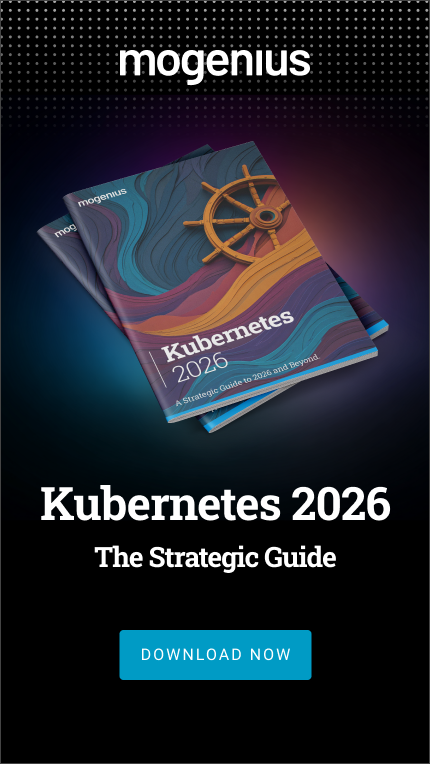
mogenius vs. Lens

Kubernetes has become the industry standard for scalable, resilient infrastructure. However, its power comes at the cost of significant operational complexity: steep learning curves, security challenges, and intricate cluster management burdens.
Two distinct philosophies have emerged to tame this complexity. The first is abstraction: building a paved road through platform-engineering that automates workflows and hides Kubernetes complexity. The second is direct control: empowering experts with intuitive interfaces for deep visibility and hands-on management.
These two approaches are embodied by two leading tools. mogenius, a cloud-agnostic platform, champions the abstraction model, focusing on developer enablement and integrated automation. In contrast, Lens, the widely adopted desktop integrated development environment (IDE), perfects the direct-control approach.
In this article, we'll compare these platforms and their underlying philosophies across key dimensions: core features, pricing, ease of use, multicloud integration, and support. Our goal is to help you decide which approach and which tool best aligns with your team's roles, experience, and strategic goals.
User Journey: Automation vs. Micromanagement
Before starting the comparison, let's explore the typical user flow for deploying an application update with each platform.
mogenius is designed around a self-service, automated process where a developer's git push can trigger a complete end-to-end deployment without further manual steps. Conversely, the typical Lens workflow requires a manual handoff to a DevOps engineer or SRE who uses the IDE for precise hands-on control over the final deployment step.
To be clear, mogenius does provide fine-grained control and observability for experts who need to access underlying resources, and Lens can indeed be automated through third-party plugins. However, it's worth noting that mogenius is built from the ground up to automate the developer's path to production, while Lens is built to empower the operator's control over it.
Platform Capabilities and Core Features
When evaluating a Kubernetes platform, it's essential to look past surface features and understand how each tool approaches core responsibilities—whether that's developer enablement, platform management, or operator-driven control.
Let's start by looking at how mogenius empowers organizations through abstraction and developer enablement:
- Abstraction layer: Operates as a secure abstraction layer, shielding developers from Kubernetes internals, which is ideal for platform engineers building internal developer platforms (IDPs).
- Professional services: Offers professional services as part of its value proposition, supporting organizations at every stage of their Kubernetes journey or scaling efforts.
- Workspaces: Utilizes workspaces and secure multitenant environments where role-based access control (RBAC) is simplified and managed via teams and projects.
- mogenius operator: Deploys the mogenius operator via Helm, enabling centralized platform management without distributing
kubeconfigfiles. - Developer experience: Provides default resource templates to reduce developer cognitive load and accelerate onboarding and deployment.
- Deployment and security: Includes a fully integrated, native CI/CD pipeline (pipeline starters), automating the "push-to-deploy" workflow from source to production.
- Monitoring and troubleshooting: Delivers aggregated, application-centric monitoring, including logs, metrics, and events consolidated for streamlined debugging at the service or workspace level.
In contrast, Lens takes a different approach, prioritizing operator-centric visibility and hands-on cluster management:
- Comprehensive IDE: Functions as a desktop IDE, providing total, unmediated cluster visibility for technical operators (DevOps, SREs, and senior developers).
- Direct cluster access: Supports local
kubeconfigconnections, granting individual operators direct, authenticated access without extra infrastructure or user management, which works well for hands-on cluster tasks and troubleshooting. - Collaborative features: Team-focused capabilities, available on the Pro and Enterprise plans (see Lens Teamwork), allow organizations to create "spaces" for managed, centralized access to clusters.
- Full Kubernetes complexity: Lens exposes the complete set of Kubernetes objects through a rich graphical interface, enabling deep precision intervention.
- Deployment and security: Does not provide built-in CI/CD; instead, integrates with external CI systems or specialized solutions like Mirantis DevOpsCare for continuous delivery workflows.
- Monitoring and troubleshooting: Equips users with real-time, high-detail pod logs, cluster events, and the standout Open Pod Shell feature for direct in-pod terminal access and advanced root-cause analysis.
Platform Capabilities and Core Features: Verdict
The choice reflects a strategic decision about organizational empowerment: mogenius favors developer velocity and safety through guardrailed automation that aligns with modern IDP goals, while Lens prioritizes total visibility and flexibility for technical experts who require unmediated access to cluster operations.
Pricing Models and Subscription Options
Both mogenius and Lens provide accessible entry points for individuals and clear scaling paths for organizations, but their pricing directly reflects their core philosophies. The choice of investment aligns with the intended self-service strategy: funding a developer-centric platform versus equipping expert operators with collaborative tooling.
mogenius uses a platform-centric software-as-a-service (SaaS) model with a modular approach that aligns with an organization's Kubernetes maturity. Their Start plan is designed for companies beginning their Kubernetes journey and running their first applications, including infrastructure setup and enablement services. The Scale plan targets organizations with existing Kubernetes setups facing operational challenges, focusing on optimization and custom integrations. The Integrate plan serves companies with established platform teams who need seamless developer onboarding and GUI integration into existing platform services. This structure allows organizations to choose services that match their current Kubernetes maturity and operational needs. Cloud resource costs from your provider are billed separately, ensuring transparency.
Lens operates on a per-user seat license model, common for professional desktop software. The Team plan is free for individuals and small organizations, providing the powerful IDE for direct, individual cluster management. However, launching a collaborative, managed self-service model for expert teams requires subscribing to the paid Pro or Enterprise plans. These tiers are essential as they unlock critical capabilities for teamwork and centralized access (Lens Teamwork), integrated security (Lens Security Center), AI-powered assistance (Lens Prism), and enterprise identity management (SSO/SCIM).
Pricing Models and Subscription Options: Verdict
The financial commitment reflects different scaling approaches: mogenius costs align with organizational Kubernetes maturity and service needs, while Lens costs scale with the number of expert users requiring premium collaborative features.
Ease of Use and Simplicity
mogenius provides a fully web-based workspace dashboard, accessible from any browser, whether using its SaaS offering or a self-hosted instance. This zero-installation model is ideal for distributed teams, ensuring a consistent experience for all users. The UI is built around guided workflows, abstracting away cluster complexity by design. For power users and automation, a complementary mogenius CLI and mogenius API allow for scripted configuration and management.
Lens is a native desktop application that must be installed on a user's local machine. Its IDE provides visual clarity for complex cluster resources. This approach is built for the expert operator with kubeconfig access. For enterprise teams, this local experience can be standardized through the Hardened Lens Desktop feature, allowing administrators to centrally enable or disable specific UI components to enforce organizational security and consistency.
Ease of Use and Simplicity: Verdict
mogenius excels at simplifying the developer's workflow and lowering the barrier to Kubernetes adoption by providing a centralized and accessible web experience, while Lens is purpose-built to streamline hands-on, expert cluster management for operators who value direct control and configuration flexibility.
Kubernetes Multicloud Provider Integration
Both platforms are engineered for modern infrastructure, offering excellent support for multicloud and hybrid environments. Their architectural differences, however, result in two distinct models for managing a diverse fleet of clusters.
mogenius supports any Kubernetes cluster conformant with the Cloud Native Computing Foundation (CNCF), from public managed clouds (like Amazon EKS, Google GKE, and Azure AKS) to private, on-premise deployments. As discussed, its universal operator creates a centralized control plane. This unifies all connected clusters into a single web interface, abstracting away provider-specific details and enabling consistent management and deployment for the entire team without handling individual user credentials.
Lens also offers broad compatibility with any Kubernetes environment via its native support for the kubeconfig file. For individual users, this provides a decentralized, user-centric model. However, Lens Pro and Enterprise introduce a centralized access layer for teams. Using Lens Teamwork and Cluster Connect, organizations can share and manage access to a portfolio of multicloud clusters through a unified "Space." This eliminates the need to manually distribute credentials, providing a secure, centrally managed discovery and access point for the team's expert operators.
Kubernetes Multicloud Provider Integration: Verdict
The core distinction lies in the approach to centralization: mogenius delivers a fully abstracted, platform-driven experience with a centralized control plane for all clusters, while Lens offers centrally managed discovery and access alongside the direct-interaction flexibility and transparency operators expect from an IDE.
Documentation and Support
Reflecting their core approaches, both platforms offer robust documentation and support, but each is tailored to a different user journey: guiding a developer on a platform versus empowering an expert with a tool.
The mogenius documentation provides a comprehensive learning ecosystem designed to onboard users of its platform. Its resources hub features a comprehensive blog with quick-start guides, administrative tutorials, and API references, supplemented by video walkthroughs and technical white papers. This approach caters to a wide range of skill levels. Support is service-oriented and tiered: Paid plans grant access to direct chat and email support, with enterprise options for dedicated SLAs and expert DevOps consulting, treating support as an integrated part of the platform service.
Lens documentation focuses on empowering its expert user base with deep technical resources and community knowledge. Its documentation is detailed and complemented by exceptionally active community forums and GitHub channels where operators solve complex issues collaboratively. For paid users, support is delivered through commercial channels and enhanced by integrated tooling. Features like the Lens Prism AI assistant provide in-context, on-demand assistance directly within the IDE.
Documentation and Support: Verdict
mogenius excels through hands-on, service-based onboarding and structured support, including professional services for tailored guidance, while Lens relies on in-depth technical documentation, community collaboration, and advanced in-tool features to equip expert operators.

Market Adoption and Platform Maturity
Both platforms are credible, secure, and established in the cloud-native ecosystem, but their paths to maturity reflect their distinct market strategies: one driven by massive, community-led adoption, the other by focused, enterprise-led implementation.
mogenius, founded in 2021, is a rapidly maturing platform whose growth is tied to the rise of the platform-engineering discipline. Its adoption is typically more strategic, driven by organizations seeking to build a managed, abstracted developer experience. From its inception, it has focused on enterprise-grade security and compliance, holding certifications like ISO 27001 and the Europrivacy seal.
Lens, founded in 2020 and now part of Mirantis, has achieved widespread grassroots adoption, establishing itself as the de facto standard IDE for practitioners. Its maturity is demonstrated by a massive global user base, an active open source community, and continuous development. Its enterprise readiness is validated by security certifications like SOC 2 and ISO 27001, making it a trusted tool for individual operators and large corporations alike.
Market Adoption and Platform Maturity: Verdict
Lens stands out for its broad, community-driven adoption and status as an industry-standard IDE, offering proven stability for expert users at any scale. In contrast, mogenius appeals to organizations seeking a strategically managed, enterprise-grade platform, reflecting the emerging trend of platform engineering as a core business discipline.
Conclusion
Both mogenius and Lens offer compelling solutions to the profound challenge of Kubernetes complexity, but they do so through fundamentally different philosophies. Mogenius champions a top-down, platform-engineering approach, using abstraction and automation to create a managed, developer-centric experience that accelerates software delivery. Lens, conversely, works from the bottom up, empowering expert operators with a feature-rich IDE that provides direct control, deep visibility, and advanced tooling for hands-on management.
In summary, the choice is not about which tool is superior but which operational model best fits your organization. If your goal is to build an internal developer platform that enables developer self-service and abstracts infrastructure, mogenius is the purpose-built solution. If your strategy is to equip a team of expert SREs and DevOps engineers with the most powerful tool kit for direct cluster control and troubleshooting, Lens is the unrivaled choice.
FAQ
Is mogenius or Lens better for developers who are new to Kubernetes?
mogenius is generally better suited for newcomers as its abstraction, automation, and guided workflows minimize the need for deep Kubernetes expertise.
Can I use mogenius and Lens together?
Yes. Teams can deploy workloads and manage environments via mogenius for simplicity while using Lens for direct inspection, debugging, or advanced configuration tasks.
Does mogenius or Lens support multicloud Kubernetes environments?
Both support multicloud integration: mogenius through its universal operator and centralized management and Lens by connecting to any cluster accessible via kubeconfig.
Interesting Reads
The latest on DevOps and Platform
Engineering trends
Subscribe to our newsletter and stay on top of the latest developments



